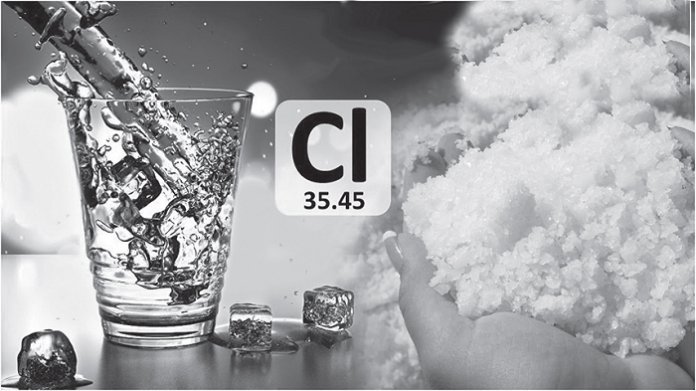Chlorine, the second lightest of the halogens is more closely linked to our everyday lives than most people think. It does more than just add flavour to the food all over the world in the form of sodium chloride. From computers to the credit cards in our wallets, from toys to tubing, from wall paint to plumbing pipes, from the flooring to the roof, it is present in every part of our homes and all around us… and even inside our bodies, in our blood, in the form of chloride ions that help maintain the right balance of electrolytes essential for the proper functioning of our cells and organs.
In the water we drink, the medicines we take, the furniture we sit on, the modes of transport we take, the mobile phones we use, chlorine chemistry is hard at work, keeping us safe and healthy, making our lives enjoyable and more comfortable.
Chlorine chemistry is also saving millions of lives annually. Even today, worldwide around 15 million people succumb to waterborne diseases every year. We can only imagine how appalling the health scene was around a century ago, before chlorination of drinking water was introduced for destroying bacteria and viruses that cause diseases like typhoid fever, cholera, dysentery, and Hepatitis A.
Around 1890, when it was discovered that chlorine was a powerful tool for disinfecting drinking water, the microbes that caused waterborne diseases were yet to be identified. But, given the sharp decline in deaths due to different diseases transmitted through water, it was amply clear that chlorine could destroy all or most of them. As LIFE magazine put it: The filtration of drinking water plus the use of chlorine is probably the most significant public health advancement of the millennium. Currently, chlorination is the most popular method adopted for disinfection and water treatment the world over.
Chlorine is the sixth most abundant element in the Earth’s crust. Our oceans too contain a huge amount of it—around 2.6 x 1016 metric tons, mostly as sodium chloride. Being aggressively reactive, chlorine easily combines with almost all other elements and is not found free in nature, occurring mainly as common salt, carnallite, and sylvite (KCl).
The luckless discoverer
Rock salt, the natural form of the most common compound of chlorine—sodium chloride—has been known to mankind since millennia. But the element (chlorine gas) was discovered only in the late 18th century. In 1774, the Swedish pharmacist Carl Wilhelm Scheele, while engrossed in carrying out one of his many experiments, heated hydrochloric acid and a piece of pyrolusite—a mineral that is mainly manganese dioxide. The reaction led to the discharge of a greenish-yellow gas. Though he didn’t know it at that time, Scheele had just discovered a new element—chlorine.
Scheele noted that the new gas had “a very perceptible suffocating smell, which was most oppressive to the lungs”, adding that it “gives the water a slightly acidic taste… the air in it acquires a yellow colour…” He also noticed the high reactivity and the bleaching qualities of this gas, describing some of his observations as “…all metals were attacked… fixed alkali was converted into common salt… all vegetable flowers—red, blue, and yellow—became white in a short time; the same thing also happened with green plants… insects immediately died.”
Unfortunately, despite such accurate observations, Scheele, going by the widely accepted ‘phlogiston’ theory of his time, thought the new gas was a ‘dephlogisticated’ form of muriatic acid (the old name for hydrochloric acid). For quite some time after that, many scientists were convinced that the gas Scheele had produced was a compound of oxygen. But, several decades later, in 1810, Sir Humphry Davy proved that the greenish-yellow gas was not a compound, but in fact an element. He suggested the new gas be called chlorine, deriving the name from the ancient Greek word ‘khlōrós’ meaning greenish-yellow or pale green.
Carl Scheele had given his life to chemical research and his many brilliant scientific achievements are widely acknowledged today. But sadly, he didn’t get the credit he deserved for many historic discoveries. His failure to publish and publicise his work in time, combined with his disinclination to attend meetings of the Royal Swedish Academy of Science, resulted in other well-known scientists getting credit for what he had discovered much earlier.
In the case of chlorine too, Scheele didn’t live to realise he was the discoverer of this important new gas. He died prematurely of several ailments including kidney failure in 1786 when he was just 43 (whereas Davy identified chlorine in 1810). Back then, there were few analytical tools and established testing methods, and hence, like the other researchers of his time, Scheele too would smell and taste the chemical compounds he tested or discovered, exposing himself to highly poisonous substances such as arsenic, mercury, lead, and hydrofluoric acid. All of these obviously played havoc with his health.
Today, chlorine gas is produced commercially through the electrolysis of sodium chloride sourced from seawater or brine from salt mines. An amazingly efficient production process, the by-products include hydrogen—used as an energy source in several manufacturing facilities, and sodium hydroxide—a versatile product used for manufacturing numerous consumer and industrial products.
A major and incredibly useful industrial chemical
With around 15000 chlorine compounds being used in industry today, chlorine is one of the most extensively used industrial chemicals and a major “building block” of industrial production.
Despite its evil-looking green-yellow colour, chlorine is one of the most beneficial elements.
Besides being used worldwide for providing safe drinking water to billions, being a powerful bleaching agent, a large amount of chlorine is also used in the paper and pulp industry. However, the most important use of chlorine is for making a host of useful chemicals such as chlorates and organic compounds such as chloroform, carbon tetrachloride, synthetic rubber, and polyvinyl chloride (PVC)—the extraordinarily versatile and durable plastic. Chlorine compounds in turn are used for manufacturing a range of products including dyestuffs, medicines, antiseptics, insecticides, household bleach, petroleum products, paints, and plastic items.
Chlorine products are used for:
- Disinfection and Sanitation
- Food production – By protecting crops from pests.
- Healthcare – Chlorine compounds are also used for manufacturing blood bags, contact lenses, safety glasses, and respiratory inhalers.
- Innovative Technology – Chlorine products play a major role in the manufacture of electronic devices, hi-performance magnets, air conditioning refrigerants, and hybrid car batteries.
- Environment Protection – In multifarious way chlorine products help in mitigating environmental problems, like to produce light weight & fuel efficient vehicles, helping higher crop yields, thus reducing the need to convert rainforests etc.
Chlorine is also a key player in the harnessing of solar energy, making it possible to obtain high-purity silicon from sand for making solar panel chips. The blades of wind turbines that help convert wind power into electricity are made from chlorine-based epoxy resins.
Smarter and comfortable transportation - Protective equipment – Military and police personnel too benefit from the chlorine chemistry used in the manufacture of strong and heat-resistant synthetic fibres out of which protective gear like bullet-resistant vests, flak jackets, and helmets are made. Similarly, chlorine chemistry is also used for manufacturing parachutes and night vision goggles.
Toxic effects
The elemental profile of chlorine is akin to that of a person with a split-personality. It has a good side, and also a dark side. On the one hand, it is amazingly useful, satisfying a number of man’s needs; but, on the other, it is extremely dangerous. Inhaling chlorine gas even for a short period could have disastrous results. A respiratory irritant, it causes excessive accumulation of fluid in the lungs leading to breathing problems. It also irritates the skin, eyes, nose, and throat and can cause burns and ulcerations.
The toxic effects of chlorine gas led to it being used as a chemical weapon for a short time during World War I. In more recent times, terrorists in Iraq blew up tankers carrying chlorine so the released chlorine gas could claim the lives or badly injure Iraqi police and civilians.
Another dreadful chlorine-related story is that of DDT — dichloro diphenyl trichloroethane. When it was first introduced as a powerful pesticide, farmers were overjoyed. It effectively killed insects, rats, and pests that destroyed their crops. However, following the overuse of this pesticide, it was found that birds and fish that fed on insects sprayed with DDT or drank water containing DDT were killed in large numbers. Soon, harmful effects were detected in humans as well. Consequently, DDT came to be banned in many developed countries. At present, one of the few permitted uses of DDT is for controlling malaria by way of fumigation or spraying of the chemical. In sub-Saharan Africa, DDT has helped drastically reduce the deaths due to malaria.
Also, CFCs (chlorofluorocarbons) once widely used in refrigeration, air conditioning, and aerosol sprays were found to damage the Earth’s protective ozone layer.
Nevertheless, we cannot deny the fact that chlorine plays a very significant role in our lives, the many benefits it offers far outweighing its undesirable effects. Not to mention, chlorine has also helped to significantly increase our life-expectancy.
References
1. Dr. Doug Stewart: Chlorine element facts – Chemicool.com, 16 Oct. 2012, https://www.chemicool.com/elements/chlorine.html
2. American Chemistry Council: Chlorine Story – https://chlorine.americanchemistry.com/Chlorine/What-is-Chlorine/Chlorine-Story/
3. Justin Rowlatt: Chlorine: From toxic chemical to household cleaner – BBC News Magazine,
4. 19 April 2014, https://www.bbc.com/news/magazine- 27057547
5. Benjamin Brodsky: Industrial Chemicals as Weapons: Chlorine – Nuclear Threat Initiative. 31 July, 2007, http://www.nti.org/analysis/articles/industrial-chemicals-weapons-chlorine/
6. American Chemistry Council Chlorine Chemistry Division: Discover Chlorine – The Element of Surprise – https://www.elementofsurprise.org
7. Daryl Weatherup: Chlorine: Protecting human health for more than a century – Greenbiz.com, 14 November, 2016, https://www.greenbiz.com/article/chlorine-protecting-human-health-more-century
8. Agata Blaszczak-Boxe: Facts About Chlorine – LiveScience.com, 24 April, 2018, https://www.livescience.com/28988-chlorine.html
9. Safe Drinking water Foundation: What is chlorination? – https://www.safewater.org/fact-sheets-1/2017/1/23/what-is-chlorination
10. Gabe Paoletti: Carl Wilhelm Scheele: The Forgotten Scientist Who Discovered Oxygen – All That’s Interesting, December 6, 2017, https://allthatsinteresting.com/carl-wilhelm-scheele.

































